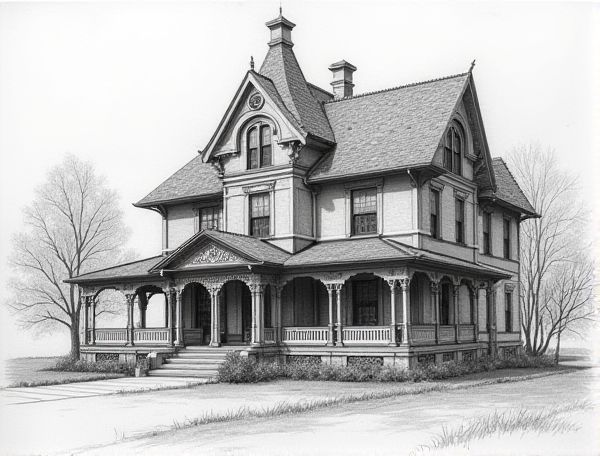
Photo illustration: Victorian home design with decorative pressed tin ceilings
Victorian home design often features ornate details and character, with decorative pressed tin ceilings adding texture and historical charm to your living spaces. Discover how these intricate ceilings can elevate your home's elegance and learn practical tips for incorporating them by reading more in the article.
Introduction to Victorian Home Design
Victorian home design features ornate detailing, asymmetrical facades, and steeply pitched roofs, reflecting the architectural styles popular during Queen Victoria's reign from 1837 to 1901. Key elements include intricate woodwork, stained glass windows, decorative trim, and vibrant color palettes that create a distinctive and elegant aesthetic.
Historical Significance of Pressed Tin Ceilings
Pressed tin ceilings originated in the late 19th century as an affordable alternative to intricate European plasterwork, adding elegance and charm to Victorian and Edwardian homes. Their embossed patterns reflect the craftsmanship and architectural trends of the period, making them a symbol of historical authenticity and design heritage. Incorporating pressed tin ceilings into your home preserves its historical significance while enhancing aesthetic appeal and value.
Key Features of Victorian Architecture
Victorian architecture showcases ornate details such as intricate woodwork, decorative trim, and steeply pitched roofs that define its timeless elegance. Bay windows, patterned brickwork, and vibrant color palettes enhance the visual appeal and historical character of Victorian homes. Your design can incorporate these key features to create a charming and distinctive living space.
Materials and Craftsmanship of Pressed Tin
Pressed tin panels, crafted from lightweight yet durable galvanized steel, offer a versatile material choice for home design, combining resilience with aesthetic appeal. The intricate patterns embossed through skilled craftsmanship enhance ceilings, walls, and backsplashes with vintage charm and architectural detail. Resistant to moisture and fire, pressed tin provides a lasting, low-maintenance surface that elevates interior spaces while preserving historical authenticity.
Popular Tin Ceiling Patterns and Motifs
Popular tin ceiling patterns often feature intricate floral motifs, geometric shapes, and Victorian-inspired designs that add timeless elegance to any room. Embossed leaves, rosettes, and medallions create a sophisticated texture that enhances your home's visual appeal while reflecting light beautifully. Choosing these classic patterns can transform your space with a distinctive vintage charm that complements both modern and traditional interiors.
Benefits of Tin Ceilings in Victorian Homes
Tin ceilings in Victorian homes enhance aesthetic appeal by preserving historical charm while offering durability and resistance to moisture and fire. Their intricate patterns add architectural interest, increase property value, and provide a cost-effective alternative to traditional plaster.
Decorative Integration: Walls, Moldings, and Ceilings
In home designing, decorative integration of walls, moldings, and ceilings enhances aesthetic appeal while maintaining architectural harmony. Custom crown moldings and wainscoting provide texture and depth, complementing painted or wallpapered walls with intricate patterns or subtle hues. Ceilings featuring coffered designs or decorative plasterwork create focal points that elevate a room's elegance and character.
Restoration Tips for Vintage Tin Ceilings
Preserve the intricate detailing of vintage tin ceilings by carefully cleaning with a mild detergent and soft brush to avoid paint damage while ensuring optimal adhesion for restoration. Your restoration project benefits from applying a rust-inhibiting primer followed by a high-quality enamel paint designed for metal surfaces, extending the ceiling's durability and aesthetic appeal.
Modern Interpretations of Victorian Tin Ceilings
Modern interpretations of Victorian tin ceilings incorporate sleek metallic finishes and minimalist patterns to blend historic charm with contemporary aesthetics. Designers often use lightweight, durable materials such as aluminum or PVC to replicate intricate motifs while improving installation ease and maintenance.
Enhancing Home Value with Decorative Pressed Tin
Decorative pressed tin adds a unique architectural element that significantly enhances home value by combining durability with aesthetic appeal. Its intricate patterns and vintage charm attract buyers seeking distinctive, high-quality materials in kitchens, ceilings, and backsplashes. Utilizing pressed tin not only elevates interior design but also provides a long-lasting, low-maintenance investment that increases property marketability.
 homedesy.com
homedesy.com